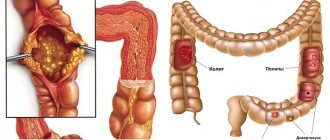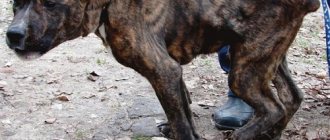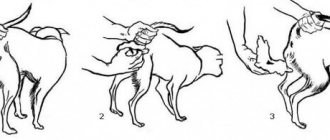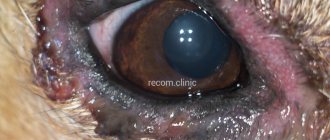Intestinal obstruction is a serious condition in dogs. In the absence or delay of help, the animal may even die. Signs of the disease can be mild and in most cases resemble simple poisoning. Some owners unknowingly ignore symptoms or self-medicate, which only worsens an already difficult situation. Therefore, it is so important to know the symptoms of intestinal obstruction in order to immediately respond and take the sick animal to the doctor.
Causes of the disease
Blockages or obstructions in dogs are divided into three main groups:
- Mechanical, the most common. Occurs for the following reasons: - incorrect dosage of food (especially relevant for starving dogs from the street); - indigestible or difficult to digest food. This includes sinews and bones, which the dog can swallow whole; - ingestion of foreign objects while walking or at home; — blockage as a result of worms after a course of deworming (manifests mainly in young dogs). Mechanical intestinal blockage is entirely the fault of the owner. Before taking an animal home, you need to study the rules of keeping and care, know about the diet and not overfeed the puppy. Deworming must be carried out strictly according to the schedule, even if you do not often walk with the puppy and he does not communicate with his relatives. For games, select appropriate toys that are sold in pet stores. Do not give your pet small sticks, foam toys, stones and small objects. If there are children in the family, then children's toys must be kept in a special play bag or closet so that the dog does not get to them.
- Pathological blockage - appears as a result of tumors in the gastrointestinal tract.
- Physiological obstruction is associated with volvulus. The main reason for this is the dog’s overactive behavior after eating a large amount of food. Also, obstruction can occur as a result of trauma to the peritoneum, compression of the intestine by other organs. Physiological obstruction is divided into: - acute - develops very quickly, accompanied by numerous symptoms. This type of blockage is very dangerous and requires immediate medical attention. The prognosis for recovery is favorable if you visit a veterinary clinic in a timely manner; - chronic obstruction, which may not manifest itself for a long time. Mainly caused by diseases of the stomach and intestines.
Clinical picture of intestinal obstruction
Signs of intestinal blockage do not always appear acutely; it all depends on the cause of the obstruction and the area of localization of foreign objects. The most striking symptoms are observed with a problem in the area of the duodenum and stomach, especially during volvulus, when the stomach twists around its axis and completely neutralizes the possibility of a food coma passing both towards the anus and through the esophagus, with vomiting.
What a dog owner can observe:
- repeated vomiting (if there is no esophageal torsion);
- increasing signs of deterioration in the pet’s well-being;
- abdominal pain;
- lethargy, refusal to feed and drink.
Sometimes, with minor intestinal obstruction, all symptoms are blurred, the breeder notices periodic vomiting, apathy, poor food intake and minor defecation disturbance. With such a course of the disease, the cause and location of the blockage can only be determined by ultrasound or fluoroscopy.
First signs
As already written above, many dog owners mistake obstruction for ordinary poisoning. It’s not surprising, because the symptoms of the diseases are very similar:
- weakness;
- decreased appetite;
- nausea and vomiting;
- bloating;
- pain in the abdomen.
These are the primary symptoms. If there is no bowel movement during a walk, the animal feels unwell, does not eat, and pain in the abdomen is noticeable in its behavior, then these are most likely signs of intestinal obstruction, and you should consult a veterinarian as soon as possible.
If you ignore the primary symptoms, your pet’s condition will worsen and lead to the following problems:
- the tone of the abdominal muscles will increase, the dog will try to stretch the hind limbs, while straining the tips of the paws;
- due to the large amount of gases, strong rumbling in the stomach will begin;
- frequent prolonged belching with an unpleasant odor;
- continuous vomiting. It is possible to excrete feces along with vomit.
With such symptoms, the dog can still be saved if you consult a specialist in time. In some cases, intestinal rupture and necrosis occurs, accompanied by dehydration. Obstruction can also be partial, but it is also dangerous and requires contacting a veterinary clinic.
Prevention
To avoid such a complex operation, it is important to remove small objects that the animal may swallow. Make sure your pet is eating properly. If there are any changes in his behavior, it is better to consult a veterinarian.
Specialists at the Best clinic perform intestinal resection and postoperative observation in Novosibirsk using modern treatment methods; screening tests are prescribed if necessary.
Another rather complex type of surgical intervention, which the clinic’s surgeons successfully cope with, is resection of the ear canal . It is performed for diseases of the organ (chronic otitis media, stenosis of the auditory canal, etc.) that are not amenable to conservative therapy.
How to help a dog at home?
The main rule for the owner of a dog with intestinal obstruction is not to self-medicate! There is no need to force your dog to eat or drink. Do not give your pet antiemetics or laxatives. Approved medications include painkillers and antispasmodics.
Even if you are outside the city, you should find an opportunity and deliver the sick animal to a veterinary clinic. A dog with intestinal obstruction dies two days after the first symptoms of the disease are detected.
Diagnosis of intestinal obstruction in dogs
The examination of a pet will only be complete in a well-equipped veterinary clinic. At home, the doctor will make a preliminary diagnosis, but to confirm it, you will need to take an x-ray of the abdominal cavity in two projections (on the side and back).
X-ray with contrast is indicated to confirm/refute intestinal patency throughout its entire length. In the pictures you can see foci of gas formation, the presence of foreign bodies, signs of peritonitis (inflammatory process with effusion) and foci of intestinal perforation. In the last two cases, emergency surgery is required to save the animal's life.
Ultrasound also gives the doctor valuable information about the condition of the internal organs and the presence/absence of fluid in the abdominal cavity. Pendulum-like bowel movements are a specific symptom of intestinal obstruction.
Treatment and diagnosis
To detect the disease, the dog must undergo a diagnostic examination, which includes:
- ultrasound examination of the abdominal cavity;
- X-ray;
- general urine and blood tests to detect intoxication;
- examination by a veterinarian, palpation of the abdomen to detect tone and pain.
If a dog has eaten a foreign body that cannot be seen with an x-ray, the pet is given a special contrast agent to accurately identify the object. After some time, the images are repeated, and depending on the movement of the contrast through the intestines, they determine where the blockage occurred.
After locating the blockage, the veterinarian will decide whether it is possible to remove the foreign body without surgery. And if such a possibility exists, then:
- the dog's intestinal tract is washed with special preparations;
- the pet is given a drip with a medicine that normalizes the functioning of the gastrointestinal tract;
- as a result of dehydration, saline solution is administered to normalize the water salt balance;
- In case of severe pain symptoms, injections of antispasmodics are given. Recovery from blockage without surgery includes:
- peace;
- a balanced diet (eating in small portions several times a day, food only in liquid form);
- peritoneal massage.
In severe cases, surgery is needed, in which the doctor determines intestinal damage and the presence of ruptures. In case of necrosis, the affected areas of the intestine are removed.
Recovery after surgery is long. On the first and second days after surgery, the dog is not fed; drips with saline are placed. The dog should be under the supervision of a doctor for about two weeks. Depending on the condition, this time may be reduced or increased. Treatment includes anti-inflammatory drugs and antibiotics.
Etiology
Intestinal obstruction in dogs develops for the following reasons:
- Ingestion of foreign objects. Most often, puppies do this. And it's not just a matter of curiosity. The cub is growing, it does not have enough minerals to form a backbone. Kids chew concrete, tear shoes and clothes. Once I had to open up a fallen puppy; its entire intestines were filled with stones.
- In adult dogs, bone blockages occur. The owners share holiday treats with the pet. The hydrochloric acid of the stomach is not able to dissolve the tubular bones. They jump further and get stuck in a narrow passage. Poultry products split lengthwise and become embedded in the intestinal wall. Food sticks to them and congestion occurs. Possible perforation of the intestinal wall with subsequent peritonitis
- Helminthiasis - excessively multiplied worms lead to intestinal blockage and even rupture. (see Dog has worms)
- Overfeeding combined with high activity. The dog begins to jump, the overfilled tube becomes bent. Large dogs - Great Danes, Dobermans, greyhounds - are prone to volvulus due to their anatomical features.
- Clogging of the intestines with coarse, indigestible food - fragments of skin, tendon fascia, shells of cereal grains.
- Pathological whelping. With prolonged compression of the intestinal tube by the fetal bladder, a compaction of food masses is formed and they stick together with the mucous membrane.
- Formation of intestinal polyps. Benign neoplasms create an obstacle to the passage of food masses.
- If the abdominal wall is injured, swelling of the internal organs develops, and the intestinal loops become compressed. With spinal bruises, innervation is disrupted, peristalsis stops, and food masses stagnate.
The dog is depressed.
With complete intestinal obstruction, the lumen is blocked, food masses do not move forward, gases do not escape, and there is no peristalsis. With partial obstruction, digestion is difficult.
Based on the speed of development of symptoms, acute and chronic obstruction are distinguished. In the first case, the pathology is eliminated using conservative methods. Chronic obstruction is cured surgically.
Treatment of intestinal obstruction
If you suspect that your pet has an obstruction, inject him with an antispasmodic - No Shpu or Papaverine, which should be in the first aid kit, and take the animal to the clinic. Don't try to treat it yourself. In case of complete obstruction, the use of potent drugs can cause intestinal rupture and death of the dog.
After diagnostic testing, the veterinarian will send the patient to the surgical table or decide to perform conservative therapy with intestinal lavage. The cost of the operation is from 10,500 rubles.
Your further actions consist of following the orders of the veterinarian. In addition to caring for the surgical suture, the remaining manipulations are almost the same for surgical and conservative treatment and consist of the following:
- Combat dehydration through intravenous drips of electrolytes.
- Detoxification therapy.
- The use of antispasmodic and analgesic drugs.
- A course of antibiotic treatment.
- Diet therapy. I recommend using Purina EN or Hill's i/d factory-made canned food.
- A course of treatment with probiotics to restore the normal flora of the large intestine.
Symptoms of intestinal blockage
You should be alert to the following symptoms:
- oppression;
- refusal to drink and eat;
- absence of stool for more than a day;
- abdominal pain;
- bad odor from the mouth;
- vomiting with fecal matter.
The dog is vomiting
If feces are found in the vomit, the situation is threatening, indicating complete obstruction.
With partial obstruction, the pathological symptoms subside, the dog drinks and eats, but after 3-4 days the painful condition returns.










